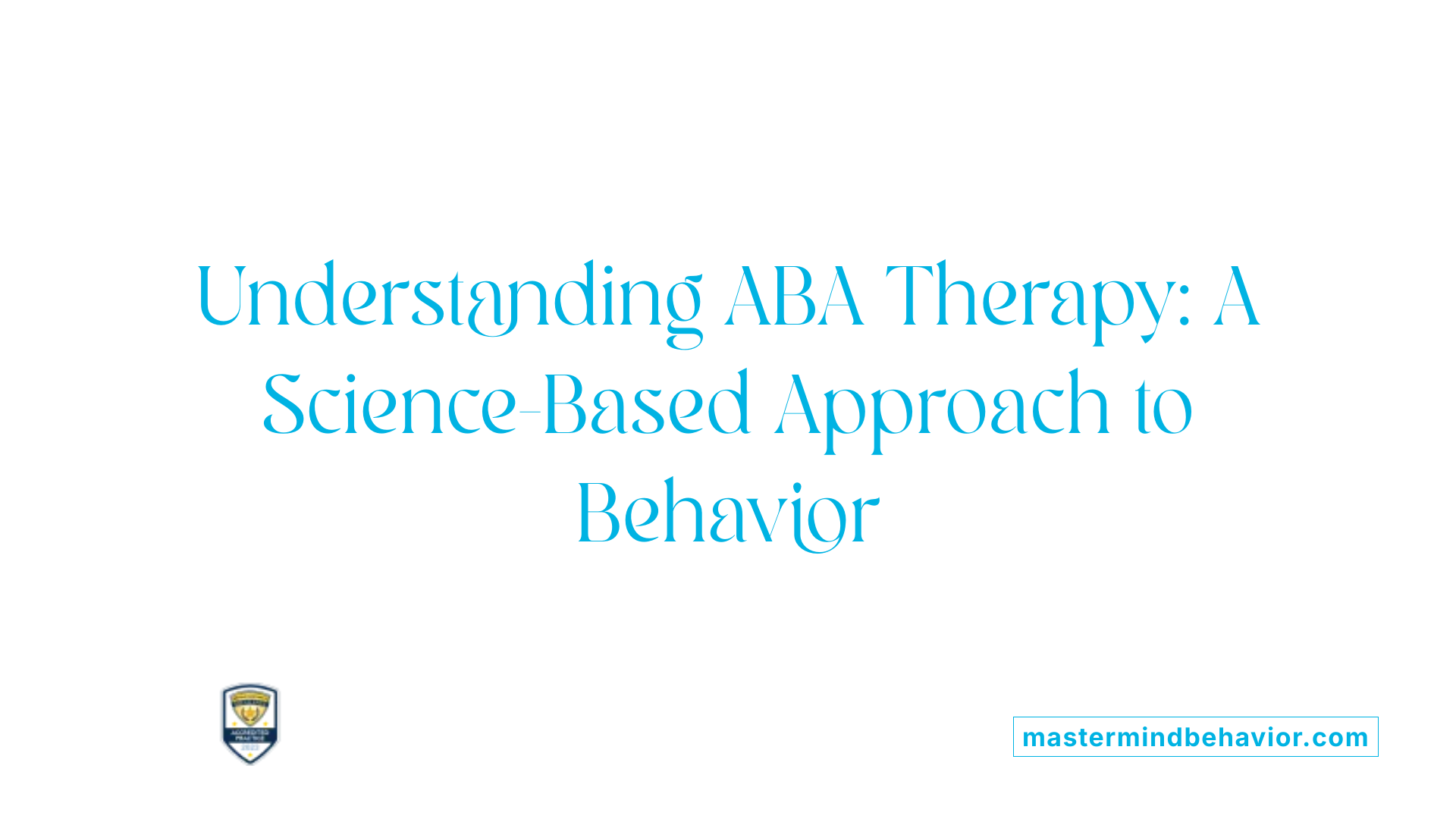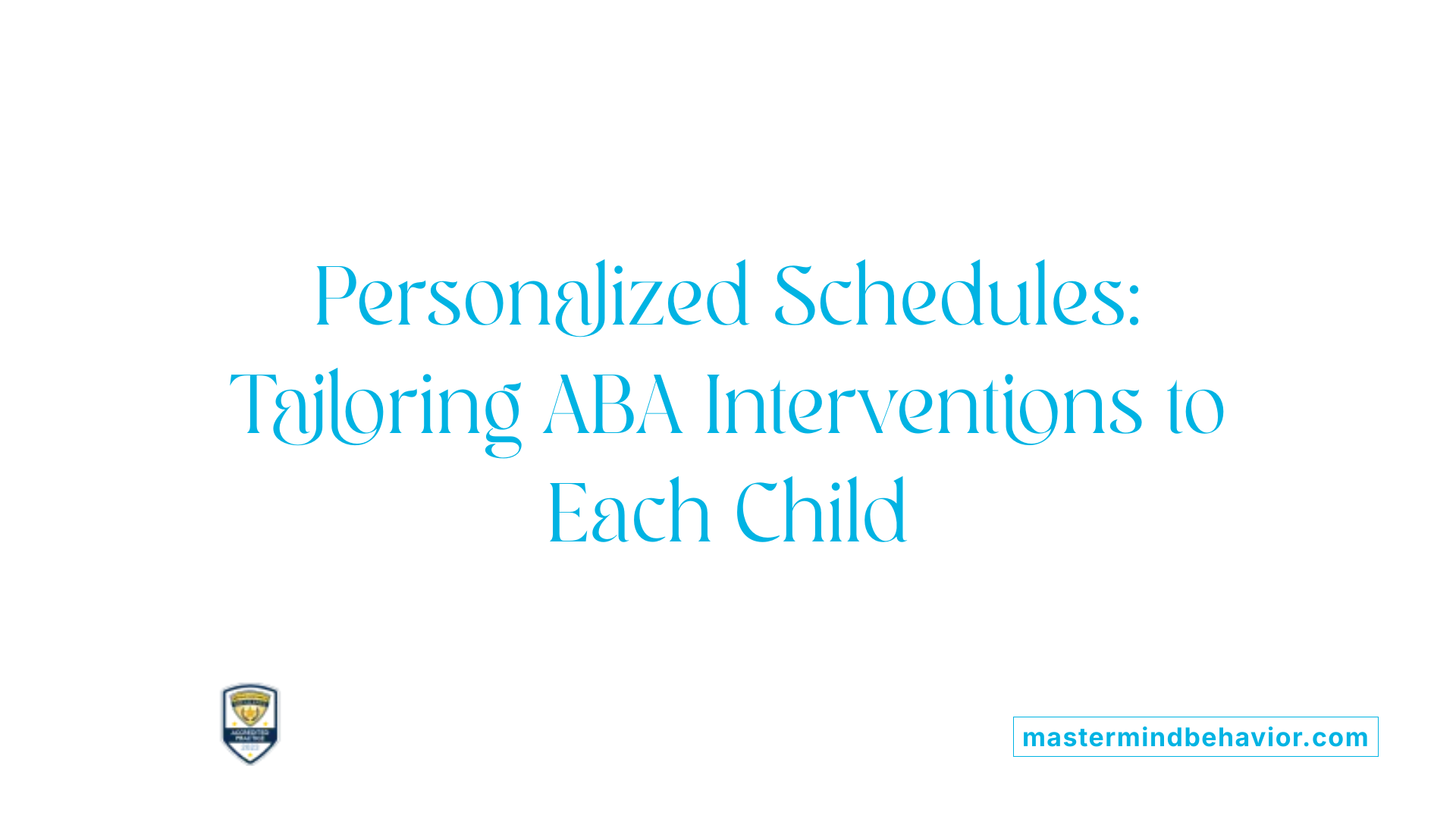ABA Therapy For Teaching Responsibility In Managing Schedules

Understanding ABA Therapy and Its Role in Developing Responsibility
Applied Behavior Analysis (ABA) therapy is a scientifically validated approach that supports individuals with autism in developing essential life skills. One critical area ABA addresses is teaching responsibility through effective schedule management. This article explores how ABA therapy fosters independence by helping children manage their daily routines, utilizing personalized schedules, family involvement, and technology to create nurturing environments that encourage skill acquisition and generalization.
What Is ABA Therapy?

What is Applied Behavior Analysis (ABA) therapy?
Applied Behavior Analysis (ABA) therapy is a scientifically validated approach that focuses on understanding and modifying behavior by examining environmental influences. It uses behavioral principles such as positive reinforcement, prompting, and extinction to encourage helpful behaviors and reduce harmful or undesirable ones, especially in individuals with autism spectrum disorder (ASD).
How does ABA therapy work and what strategies are used?
ABA therapy employs strategies including pivotal response training, discrete trial training, and verbal behavior interventions. Central to ABA is the ABC model — Antecedent, Behavior, Consequence — which helps analyze the triggers and outcomes of behaviors to effectively modify them. Positive reinforcement is a vital technique where rewards increase desirable behaviors, promoting independence and skill acquisition.
How is the treatment individualized?
ABA treatment is highly individualized and tailored according to assessments conducted by trained professionals such as Board Certified Behavior Analysts (BCBAs). Programs are developed by evaluating the child’s routines, preferences, and developmental goals. Therapists collaborate closely with families to design schedules and interventions that fit naturally within the child's daily environment.
What skills does ABA therapy target?
ABA aims to teach appropriate behaviors, improve language and social functioning, enhance self-care and academic skills, manage challenging behaviors, and foster independence. Early intervention using ABA is especially beneficial for helping children with autism build foundational skills and improve their quality of life.
Where does ABA therapy take place and who participates?
ABA therapy can be delivered in various settings such as the home, school, and community. Home-based ABA therapy involves integrating therapy into daily routines through visual supports, predictable schedules, and family involvement. Parents and siblings are trained in ABA strategies like prompting and reinforcement to support consistent learning and help generalize skills across settings.
What research supports ABA therapy?
Extensive research validates ABA as an effective, evidence-based approach. Intensive, early intervention programs have shown significant improvements in social, communication, and cognitive outcomes for individuals with autism. Close collaboration between therapists and families, ongoing data collection, and adjustments ensure that treatments remain responsive and effective.
How ABA Therapy Benefits Individuals with Autism in Managing Schedules
How does ABA therapy help individuals with autism?
ABA therapy helps individuals with autism by breaking down complex behaviors into smaller, manageable parts and using positive reinforcement to encourage these desired behaviors. It systematically teaches new skills such as communication, social interactions, daily living tasks, and academic abilities. Through individualized assessments, therapists design treatment plans that match the child's unique needs and preferences, which promotes better engagement and learning.
What techniques are used in ABA therapy?
Common techniques include:
- Discrete Trial Training (DTT): Structured teaching sessions that focus on one skill at a time.
- Pivotal Response Training: A play-based method to target motivation and self-management.
- Verbal Behavior Intervention: Emphasizes language skills development. These methods are combined and adapted to fit the individual’s learning style and daily routines.
What role does positive reinforcement play?
Positive reinforcement is at the heart of ABA therapy. When a child performs a desired behavior, they receive a reward or praise, increasing the likelihood of that behavior repeating. This approach promotes independent skills by gradually reducing reliance on prompts and rewards.
How are individualized strategies developed?
Therapists collaborate closely with families to assess routines, preferences, and needs. They create flexible schedules with buffer times to manage disruptions, using visual aids and consistent routines to foster understanding and engagement. Families receive training to implement ABA techniques, ensuring consistency and encouraging skill generalization across environments.
Which skill areas are improved through ABA?
ABA supports improvements in:
- Communication and language
- Social interaction
- Daily living and self-care
- Academic and cognitive abilities
- Behavioral regulation
How does ABA therapy promote independence?
By teaching appropriate behaviors and reducing problem actions, ABA prepares individuals for more autonomous living. Skills learned through therapy are practiced in real-life home and community settings, involving family and siblings to support generalization. Over time, individuals gain greater self-sufficiency and reduced dependence on caregivers.
Who Provides ABA Therapy? Professionals Guiding Schedule Management
Types of ABA Providers
ABA therapy is typically delivered by a team of trained and certified professionals. Key providers include Board Certified Behavior Analysts (BCBAs), Registered Behavior Technicians (RBTs), and licensed clinical therapists with specialized training in applied behavior analysis. These experts bring distinct roles to ensure therapy is tailored and effective.
Certifications and Training
Professionals working in ABA therapy undergo rigorous certification and training. BCBAs often hold graduate-level degrees and have passed a certification exam, qualifying them to design and supervise intervention plans. RBTs receive specialized training to implement these plans under supervision. This structured training ensures the consistency and quality of therapy delivered.
Treatment Plan Development
ABA therapists create individualized treatment plans based on comprehensive assessments of each child's behavior, preferences, and goals. These plans incorporate behavioral strategies such as the ABC (Antecedent-Behavior-Consequence) model, positive reinforcement, and selected techniques like pivotal response training or discrete trial training. Customizing the plan helps optimize learning and skill acquisition.
Settings of Therapy Delivery
ABA therapy can be delivered across various settings including private clinics, schools, hospitals, community mental health centers, residential facilities, and notably, in the home environment. Home-based ABA therapy integrates skill-building into the child's natural routines and surroundings, fostering generalization and practical application.
Methods Applied
Therapists apply evidence-based methods grounded in behavioral theory. Techniques range from direct teaching during discrete trials to embedded instruction within daily activities. Visual aids, technology tools, and consistent routines are utilized to boost engagement and learning. Flexibility in scheduling and buffer times accommodate unforeseen changes, enhancing therapy’s effectiveness.
Therapist-Family Collaboration
A cornerstone of ABA’s success is close collaboration between therapists and families. Therapists design and implement interventions while parents and siblings support learning by reinforcing skills and embedding strategies into daily life. Regular communication, feedback exchange, and family training in ABA techniques ensure therapy adapts effectively to the child’s evolving needs.
This coordination between certified providers and families creates a supportive environment that maximizes therapy outcomes and helps children with autism develop vital skills for independence and social integration.
Key Behavioral Areas Addressed by ABA in Schedule Responsibility
What areas of behavior does ABA therapy address?
ABA therapy addresses a wide scope of behavioral areas to support developmental growth and promote independence. One primary focus is on communication skills, which include improving speech and language abilities, functional communication, and social communication. This encompasses pragmatic language skills such as understanding and using non-verbal cues effectively.
Social behaviors represent another major area targeted by ABA, featuring skills like turn-taking, emotion recognition, empathy, perspective-taking, social initiation, and conflict resolution. Strengthening these skills helps children engage successfully in interpersonal interactions.
Additionally, ABA works to reduce maladaptive behaviors by applying principles from the ABC (Antecedent-Behavior-Consequence) model. This model helps identify triggers and consequences of behaviors, enabling therapists to design individualized behavior interventions that modify undesirable actions.
The therapy's personalized approach ensures that interventions are tailored to specific skill development goals for each child. Techniques such as discrete trial training, verbal behavior intervention, and pivotal response training are selected based on these individual needs.
By addressing areas like communication, social functioning, and behavior management through evidence-based strategies, ABA promotes positive behavioral changes and prepares individuals for greater independence.
Creating Individualized, Effective Schedules in ABA Therapy

Assessing Child's Routines and Preferences
Establishing an effective ABA therapy schedule starts with closely assessing the child's daily routines and personal preferences. Understanding when the child is most receptive and what environments suit their learning style is essential for engagement.
Tailoring Schedules to Needs and Goals
Schedules are customized to align with the child's specific developmental goals and behavioral needs. This personalized approach ensures that therapy sessions focus on relevant skills, maximizing the impact of interventions.
Maximizing Therapy Effectiveness
A tailored schedule allows therapists to introduce interventions at optimal times, balancing intensity with the child's endurance. Flexibility to adjust session timing also helps accommodate any unforeseen disruptions, maintaining consistent progress.
Use of Visual Schedules and Aids
Visual supports such as picture cards and visual schedules play a crucial role in home-based ABA therapy. They provide clear, predictable routines that help children understand what to expect, reducing anxiety and promoting smoother transitions between activities.
Embedding Instruction in Daily Routines
Integrating therapy within daily home activities embeds learning opportunities throughout the day. This embedded instruction helps reinforce skills in natural contexts, aiding generalization and supporting consistent skill acquisition outside formal sessions.
By combining careful assessment with personalized, visually supported, and routine-embedded schedules, ABA therapy can become more effective and responsive to each child's unique needs.
Establishing Consistency Through Routines and Visual Supports
Why Are Routines Important in ABA Therapy?
Consistent routines provide structure that helps children with Autism Spectrum Disorder (ASD) understand what to expect throughout their day. This predictability reduces anxiety and creates a sense of security, which is essential for effective learning. In home-based ABA therapy, routines make it easier to embed skill-building exercises naturally into daily life, ensuring that therapy is both consistent and practical.
What Role Do Visual Schedules Play?
Visual schedules act as clear, easy-to-understand guides that outline daily activities and therapy tasks. They use pictures, symbols, or words matched to the child's preferences, making abstract concepts more concrete. By seeing the sequence of activities, children gain a better grasp of expectations and transitions, which boosts their engagement during therapy sessions.
How Does Predictability Aid Understanding?
When children can anticipate what comes next, it reduces stress and helps them focus on learning new skills. Predictable routines combined with visual supports clarify expectations, minimizing confusion or disruptive behaviors. This supportive framework promotes smoother transitions and facilitates the child's ability to follow instructions.
How Do Routines and Visual Supports Promote Engagement?
By integrating therapy tasks seamlessly into daily schedules and using visual cues tailored to the child's interests, engagement increases naturally. Children are more motivated and involved when they understand tasks and routines clearly. This approach helps maintain attention, making therapy sessions more productive and enjoyable.
Family Involvement: Strengthening Schedule Management Responsibility
How Do Therapists and Families Collaborate in ABA Therapy?
Collaboration between therapists and families forms the backbone of effective home-based ABA therapy. Therapists design and implement behavior analysis techniques tailored to the child’s needs, while family members create supportive environments and reinforce these skills throughout daily life. This partnership ensures that therapy goals align with the child’s routines and preferences.
What Training Do Parents and Siblings Receive in ABA Techniques?
Training family members in ABA strategies such as prompting and positive reinforcement empowers them to actively participate in the therapy process. Parents and siblings learn practical skills like managing schedules, using visual supports, and embedding instruction into routine activities. This knowledge enables consistent reinforcement of targeted behaviors and promotes seamless integration of therapy into everyday life.
How Is Skill Reinforcement Managed at Home?
Families play a vital role in reinforcing newly acquired skills from therapy sessions. By incorporating ABA techniques into daily routines, such as meal times or play, parents ensure that learning continues beyond formal sessions. Visual schedules and clear, predictable routines help the child understand expectations, supporting ongoing engagement and progress.
In What Ways Does Family Involvement Improve Dynamics and Support?
Involving the entire family fosters positive dynamics by building understanding and empathy around the child's needs. It also enhances the home support system, creating a nurturing environment conducive to skill development and behavior management. Regular communication and feedback between therapists and families help address challenges promptly and adapt therapy plans effectively.
Integrating Therapy Into Daily Life for Generalization of Skills

How can ABA strategies be embedded in everyday activities?
In home-based ABA therapy, embedding strategies directly into daily routines is essential for helping children practice and generalize new skills. This means using natural opportunities, like mealtimes or playtime, to reinforce behaviors and teach skills through embedded instruction. Visual supports, including picture cards and schedules, provide clear expectations and help children understand their routines.
How are skills practiced across different settings?
To ensure skills transfer beyond therapy sessions, consistent practice is encouraged across various environments, such as the home, community centers, or schools. Therapists work with families to adapt activities so that children can engage in skill-building throughout their day, which helps make the learning process relevant and enduring.
What role does community involvement play in ABA therapy?
Community involvement is vital for broadening a child’s social experiences and promoting independence. Incorporating siblings and other family members, as well as participating in community outings, allows children to apply skills in social contexts. This engagement supports social integration and enhances generalization by exposing children to diverse situations and people.
How is skill generalization and social integration promoted?
Promoting generalization involves systematically extending learned skills to new settings and people. This is achieved by involving the entire family, establishing predictable routines, and practicing behaviors in different environments. Positive reinforcement and consistent collaboration between therapists and families ensure that skills are maintained and expanded, ultimately supporting the child’s development toward greater independence and social participation.
Creating a Conducive Learning Environment for Schedule Responsibility
Minimizing Distractions
A productive home-based ABA therapy session begins with a learning environment free from unnecessary distractions. This can include choosing a quiet, dedicated space for therapy that limits background noise and interruptions, helping the child to maintain focus.
Using Visual Aids Tailored to Preferences
Visual aids, such as picture cards and visual schedules, play a vital role in ABA therapy. Tailoring these aids to the child’s preferences ensures they are appealing and understandable, which supports comprehension and anticipation of activities.
Enhancing Engagement and Learning
Reflecting the child's interests within therapy activities increases motivation and engagement. Incorporating favorite toys, topics, or themes into lessons makes learning more enjoyable and meaningful, fostering consistent participation.
Reflecting Child's Interests
Recognizing and including the child’s unique likes not only strengthens engagement but helps in building a supportive environment where the child feels valued. This personalization promotes positive associations with therapy sessions, aiding skill acquisition and retention.
Utilizing Technology to Support Schedule Management Skills
How Can Apps Enhance Visual Scheduling in ABA Therapy?
Apps designed for visual schedules play a crucial role in home-based ABA therapy by providing clear and consistent routines tailored to each child's needs. These digital tools often include customizable picture cards and interactive timers, helping children understand daily expectations and transitions. By engaging children visually, apps increase motivation and participation, which are essential for effective learning.
What Role Does Virtual Conferencing Play in Therapy and Communication?
Virtual conferencing platforms offer a flexible means for therapists and families to connect regularly despite distance or scheduling challenges. Through video calls, therapists can observe sessions, provide real-time guidance to parents, and adjust strategies efficiently. This remote interaction ensures continuous support and timely modifications to therapy plans, making therapy more responsive and accessible.
How Is Technology Used to Reinforce Skills Beyond Therapy Sessions?
Technology extends learning opportunities outside formal therapy hours by allowing parents to access resources and practice activities at home. Apps often feature reminders, interactive exercises, and positive reinforcement tools that promote skill generalization in everyday environments. This continual engagement helps maintain consistency and accelerates progress.
In What Ways Does Technology Facilitate Parent-Therapist Collaboration?
Communication tools like secure messaging apps and shared digital logs enable seamless exchange of feedback and data between therapists and families. These platforms support tracking progress, scheduling adjustments, and sharing observations promptly. By facilitating ongoing dialogue, technology strengthens partnership, ensuring that therapy remains adaptive to the child's evolving needs.
Flexibility and Adaptability in ABA Therapy Scheduling
Why is flexible scheduling important in ABA therapy?
Flexible scheduling is essential in ABA therapy to accommodate the dynamic needs of the child and family. Since therapy is often integrated into daily routines, unexpected events can disrupt planned sessions. By maintaining a flexible approach, therapists and families can ensure that the child's engagement and progress remain consistent without added stress.
How do buffer times help manage unforeseen events?
Incorporating buffer times into the therapy schedule allows for adjustments when interruptions occur, such as illness, family emergencies, or changes in the child's mood. These extra time slots prevent session overlap and provide the opportunity to revisit missed activities, ultimately supporting continuous learning without overwhelming anyone involved.
How do therapists and families communicate to support flexible scheduling?
Open communication is fundamental to adapting therapy plans effectively. Therapists and parents regularly exchange feedback about the child's responses and any logistical challenges. This collaboration allows them to modify session timing, frequency, or goals promptly, ensuring the therapy aligns with the child's evolving needs and the family's availability.
When and how are therapy plans adjusted based on progress and circumstances?
Therapy plans are routinely reviewed through data collection and observations of the child's behavior and skill development. If progress slows or circumstances change—for example, entering a new school environment or family schedule shifts—therapists collaborate with families to refine goals and strategies. Adjustments may include changing techniques, altering schedules, or involving different caregivers in therapy activities to maintain effectiveness.
Maintaining flexibility in scheduling, supported by open communication, buffer planning, and responsiveness to progress, enhances the overall success of home-based ABA therapy.
Data Collection and Progress Monitoring in Schedule Management
How Does Tracking Behavioral Changes Support ABA Therapy?
Tracking behavioral changes is essential in ABA therapy to understand how a child responds to different interventions. By systematically recording behaviors, therapists and parents can identify patterns of improvement or areas needing further support. This tracking helps ensure that the therapy remains aligned with the child's unique needs and goals.
How Is Observation Data Used to Modify Therapy?
Observation data collected during sessions provides insights into the effectiveness of specific strategies. Therapists use this information to adjust techniques, such as prompting or reinforcement methods, to improve engagement and learning outcomes. Incorporating real-time observations allows therapy plans to remain flexible and responsive.
How Does Progress Data Inform Individualized Adjustments?
Regularly gathered data informs the customization of the therapy schedule and activities. For example, if a child shows rapid progress in language skills, therapists might introduce more advanced tasks. Conversely, if challenges arise, the approach can be modified to better support skill development. This individualized adjustment ensures therapy stays maximally effective and relevant.
Why Is Regular Feedback Important in ABA Therapy?
Regular feedback between therapists and family members fosters clear communication and collaborative problem-solving. Sharing progress updates and challenges ensures that everyone involved is informed and can contribute to decision-making. This ongoing dialogue supports consistency across different environments, reinforcing learning and promoting the generalization of skills.
| Aspect | Purpose | How It Enhances Therapy |
|---|---|---|
| Behavioral Tracking | Measures changes in skills and behaviors | Identifies successes and areas for intervention adjustments |
| Observation Data | Provides detailed session insights | Enables timely modifications for improved efficacy |
| Individualized Adjustments | Tailors therapy to current performance | Keeps therapy relevant and challenging |
| Regular Feedback | Facilitates communication among stakeholders | Builds a supportive, collaborative environment |
ABA Techniques Supporting Responsibility and Independence
What is Positive Reinforcement and How Does It Encourage Independence?
Positive reinforcement is a foundational ABA strategy that involves rewarding desired behaviors to increase their occurrence. In the context of developing responsibility and independence, this technique encourages individuals to engage in appropriate actions by providing motivating rewards. For example, a child might receive praise or a small reward after completing a daily task independently, strengthening their motivation to repeat the behavior.
How is the ABC Model Applied in Teaching Responsibility?
The ABC model—Antecedent, Behavior, Consequence—is critical for understanding and modifying behaviors. By analyzing what triggers a behavior (antecedent), the behavior itself, and what follows it (consequence), therapists can craft interventions that promote responsible actions. For instance, setting clear cues before a task and consistently reinforcing positive completion helps children learn the expected behavior and its rewards.
What is Pivotal Response Training and Its Role?
Pivotal Response Training (PRT) focuses on pivotal areas of a child’s development such as motivation and self-management. This naturalistic approach encourages children to take initiative in learning new skills related to responsibility by following their interests and making choices. PRT enhances generalization by embedding learning in routine activities, promoting independence across different settings.
How Does Discrete Trial Training Help in Skill Acquisition?
Discrete Trial Training (DTT) breaks down complex skills into small, manageable steps taught systematically through repeated trials. This method supports responsibility by teaching precise tasks clearly and providing immediate feedback. With consistent practice under DTT, children can master foundational skills necessary for independent living.
What are Verbal Behavior Interventions and Their Impact?
Verbal Behavior Interventions focus on teaching communication skills, crucial for expressing needs and making responsible decisions. By enhancing functional language and social communication, these interventions empower children to interact effectively, request help, and participate actively in daily responsibilities.
Together, these ABA techniques create a comprehensive framework that fosters responsibility and independence by targeting motivation, behavior understanding, skill breakdown, and communication ability.
The Role of Early Intervention in Developing Schedule Management Skills

Why is early ABA intervention important?
Early intervention using Applied Behavior Analysis (ABA) is crucial for children with Autism Spectrum Disorder (ASD). Starting therapy early helps lay the groundwork for essential skills like schedule management, which supports everyday functioning. Children who begin ABA therapy at a young age often experience better developmental outcomes and increased independence later in life.
How does early intervention support foundational skill development?
ABA therapy focuses on building foundational skills, including understanding and following daily routines. By introducing consistent, tailored schedules early, children learn to manage expectations and transitions smoothly. These foundational abilities promote confidence and reduce frustration as routines become more predictable and understandable.
In what ways does early ABA improve quality of life?
Personalized early ABA programs integrate therapy into the child’s natural home environment. This promotes generalization of skills, allowing children to apply what they learn to everyday activities, enhancing engagement and participation. Improved skill sets through early intervention contribute to better communication, social interaction, and self-care, all of which enhance overall quality of life.
What are the long-term benefits of early intervention for independence?
Consistent early ABA therapy teaches appropriate behaviors and reduces reliance on caregivers over time. Children gain independence in scheduling and managing daily tasks, preparing them for life beyond childhood. This early foundation often leads to greater success in school and community settings, supporting lifelong autonomy.
Early intervention is a powerful step in ensuring children with ASD develop the skills needed to thrive within their families and communities.
Therapist and Family Collaboration: The Key to Effective Schedule Management

How Does Shared Feedback and Communication Enhance ABA Therapy?
Effective home-based ABA therapy thrives on open communication between therapists and families. Regular exchanges of feedback allow for close monitoring of the child's progress and quick identification of any challenges. This dialogue ensures that treatment plans remain responsive to the child's evolving needs, fostering a dynamic and adaptive approach to therapy.
Why Is Cooperation Vital in Implementing ABA Strategies?
Therapists design behavior analysis techniques, but the family's cooperation in applying these strategies within daily routines is crucial. Parents and siblings trained in ABA methods such as prompting and positive reinforcement maintain consistency beyond therapy sessions. This collaboration maximizes skill acquisition and supports the child in generalizing learned behaviors.
How Are Treatment Plans Adjusted Through Therapist-Family Collaboration?
Home-based ABA therapy requires flexibility. Families and therapists work together to adapt schedules and intervention techniques in response to unforeseen events or developmental changes. Buffer times are incorporated to accommodate disruptions, while shared observations inform data-driven modifications to individual treatment plans.
What Role Does Consistency Across Environments Play?
Ensuring that the child experiences consistent expectations and reinforcement across home and community settings is vital. Therapist-family collaboration fosters this consistency by integrating therapy into everyday activities and training family members to reinforce skills. This unified approach strengthens the child's learning and promotes independence.
Concluding Thoughts on ABA Therapy and Schedule Responsibility
ABA therapy provides a robust and evidence-based framework for teaching responsibility in managing daily schedules to individuals with autism. By combining individualized schedules, family involvement, visual supports, and flexible approaches, ABA empowers children to develop independence that can transfer across environments. Collaborative efforts between therapists and families, along with modern technological tools and data-driven adjustments, ensure that therapy remains dynamic and effective in addressing each child's unique needs. Early intervention and consistent practice embed these skills deeply, enhancing overall quality of life and fostering long-term autonomy. Ultimately, ABA therapy not only shapes behaviors but also builds vital life skills that promote dignity and self-reliance in managing everyday responsibilities.
References
- Home-Based ABA Therapy Scheduling Strategies
- How to Treat Autism Using Applied Behavior Analysis
- Mastering Home-Based ABA Therapy Scheduling Strategies
- Applied Behavior Analysis (ABA)
- 6 Benefits of ABA Therapy for Children with Autism
- Applied Behavior Analysis (ABA)
- Applied Behavior Analysis (ABA)
- ABA 101 handouts
Recent articles

The Role Of ABA Therapy In Managing Perseverative Behaviors
Understanding How ABA Therapy Effectively Addresses Perseverative Behaviors

How Reinforcement Works in ABA Therapy: Best Practices
Unlocking Behavior Change: Reinforcement Strategies in ABA Therapy

Using ABA To Teach Safety Skills Like Crossing The Street
Empowering Children with Autism Through Effective Safety Training

Preparing for Transition to Adult Services With ABA Foundations
Critical Steps in Navigating Autism Transition Milestones

ABA Therapy To Reduce Escape Maintained Behaviors
Effective Strategies in ABA for Addressing Escape-Driven Behaviors

How ABA Therapy Supports Children In Building Long-Term Friendships
Fostering Lifelong Bonds: The Role of ABA in Social Skills Development



